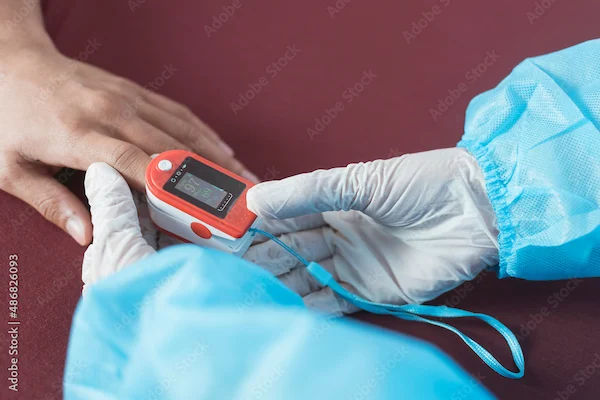Blood Oxygen Levels and Hypoxemia: Causes, Symptoms, and Treatment
Learn about blood oxygen levels, causes of hypoxemia, symptoms, diagnosis, and treatment options. Discover prevention strategies for maintaining healthy oxygen levels.

Written by Dr.Sonia Bhatt
Last updated on 3rd Jul, 2025

Introduction
Oxygen is essential for your body to function properly. Your blood carries oxygen to organs and tissues to ensure they work efficiently. Blood oxygen levels indicate how well your lungs and circulatory system are delivering oxygen throughout your body. A normal oxygen level typically ranges between 95% and 100%. If your oxygen saturation drops below 90%, it may indicate an underlying health issue that requires medical attention.
When these levels drop too low, it can lead to a condition known as hypoxemia. The condition can result in shortness of breath, fatigue, confusion, and other serious complications if not addressed promptly. If untreated, hypoxemia can lead to organ damage and other complications. Understanding blood oxygen levels and recognising the signs of hypoxemia can help you take the necessary steps to manage your health effectively.
Causes of Hypoxemia
Hypoxemia can develop due to various conditions affecting oxygen intake, blood circulation, or the body’s ability to use oxygen efficiently. Recognising the causes can help you take preventive measures and seek timely treatment.
1. Respiratory System Disorders
Lung-related conditions can impair oxygen absorption, leading to low blood oxygen levels. Some common causes include:
Chronic obstructive pulmonary disease (COPD), which limits airflow and oxygen exchange.
Asthma, where inflammation narrows airways, making breathing difficult.
Pneumonia, an infection that fills the lungs with fluid, reducing oxygen intake.
Pulmonary embolism, where a blood clot blocks oxygen flow in the lungs.
If you have a lung condition, regular monitoring of oxygen levels can help prevent complications.
2. Circulatory System Disorders
Heart and blood vessel conditions can affect oxygen transport, even if your lungs function normally. Some common circulatory causes of hypoxemia include:
Heart failure
Congenital heart defects
Anaemia
Addressing these conditions through medication, lifestyle changes, or medical intervention can help maintain healthy oxygen levels.
Symptoms of Hypoxemia
If your blood oxygen levels drop, your body may show signs of distress. The severity of symptoms depends on how low your oxygen levels are and how quickly they decrease.
1. Mild Symptoms
Mild hypoxemia may not cause immediate concern, but if left untreated, it can worsen over time. Common early symptoms include:
Shortness of breath, especially after exertion.
Fatigue and reduced energy levels.
Headaches and dizziness.
Increased heart rate as your body tries to compensate for low oxygen.
If you notice these symptoms frequently, checking your oxygen levels can help determine if a medical evaluation is necessary.
2. Severe Symptoms
Severe hypoxemia can become a medical emergency, leading to life-threatening complications. Signs that require urgent attention include:
Confusion, difficulty concentrating, or slurred speech.
Bluish skin, lips, or fingernails (cyanosis).
Chest pain and irregular heartbeat.
Extreme breathlessness, even at rest.
If you or someone around you experiences these symptoms, seeking immediate medical help is essential to prevent organ damage or respiratory failure.
Consult Top Specialists for Your Symptoms
Diagnosis of Hypoxemia
If you experience symptoms like shortness of breath, fatigue, or dizziness, testing your blood oxygen levels can help determine whether you have hypoxemia. Doctors use different diagnostic methods to measure how much oxygen is circulating in your blood and whether immediate intervention is needed.
1. Pulse Oximetry
Pulse oximetry is a quick and non-invasive way to check your blood oxygen levels. A small device called a pulse oximeter is clipped onto your finger, ear, or toe to measure oxygen saturation (SpO₂). Normal readings typically range from 95% to 100%, while levels below 90% may indicate hypoxemia. This test is widely used for monitoring oxygen levels at home and in hospitals, especially for people with respiratory conditions.
2. Arterial Blood Gas Analysis
For a more detailed analysis, an arterial blood gas (ABG) test is performed by drawing blood from an artery, usually in the wrist. This test measures oxygen levels (PaO₂), carbon dioxide levels, and blood pH to assess how well your lungs are oxygenating your blood. ABG testing is more accurate than pulse oximetry and is often used in emergency situations or for monitoring severe lung diseases.
3. Normal Ranges and Interpretation
A healthy oxygen saturation level usually falls between 95% and 100%. Levels below 90% may indicate hypoxemia and require further evaluation. Extremely low levels, below 80%, can be life-threatening and demand urgent medical intervention. If your oxygen levels are consistently low, identifying the underlying cause is crucial for effective treatment.
Risk Factors for Hypoxemia
Several factors can increase your risk of developing hypoxemia. These include underlying medical conditions as well as environmental and lifestyle influences that affect oxygen absorption and circulation.
1. Medical Conditions
Certain health conditions can interfere with oxygen intake and transport. If you have any of the following, you may be at higher risk of hypoxemia:
Chronic obstructive pulmonary disease (COPD)
Asthma
Heart failure
Anaemia
Managing these conditions with medication and lifestyle adjustments can help reduce the risk of oxygen deprivation.
2. Environmental and Lifestyle Factors
Your surroundings and daily habits can also impact your oxygen levels. Common risk factors include:
High altitudes, where oxygen levels in the air are lower, making breathing more difficult.
Exposure to air pollution, which can damage lung function over time.
Smoking, which reduces lung capacity and oxygen absorption.
Obesity, which may contribute to breathing difficulties, especially during sleep.
Avoiding exposure to pollutants, maintaining a healthy weight, and quitting smoking can improve oxygen intake and overall lung health.
Treatment and Management of Hypoxemia
If you have hypoxemia, treatment focuses on increasing oxygen levels and addressing the underlying cause. The right approach depends on the severity of your condition and whether an immediate intervention is required.
1. Oxygen Therapy
Oxygen therapy is often used when your blood oxygen levels drop below safe limits. Depending on your needs, it can be provided in different ways:
Nasal cannulas deliver low-flow oxygen for mild cases.
Face masks are used for higher oxygen requirements.
Ventilators are needed in severe cases where breathing assistance is required.
Oxygen therapy helps restore normal oxygen levels, reducing symptoms like breathlessness and fatigue.
2. Addressing Underlying Causes
Managing hypoxemia effectively involves treating the condition responsible for low oxygen levels. This may include:
Medications for lung diseases, such as bronchodilators for asthma or COPD.
Lifestyle changes, including quitting smoking and maintaining an active routine.
Surgery, in cases where structural lung or heart issues affect oxygen circulation.
By identifying and addressing the root cause, you can improve oxygen levels and reduce the risk of complications.
Consult Top Doctors for Personalised Treatment
Complications Associated with Hypoxemia
If your body does not receive enough oxygen, it can lead to serious complications affecting multiple organs. The severity of these complications depends on how low your oxygen levels drop and how long the condition persists. Addressing hypoxemia early helps prevent further damage and improves overall health.
1. Short-term Complications
When oxygen levels drop suddenly, your body may struggle to function properly. Some immediate complications include:
Dizziness and confusion
Increased heart rate and breathing difficulties
Fatigue and weakness
Cyanosis, a condition in which your lips and fingertips may turn blue due to oxygen deprivation.
Short-term complications can become severe if oxygen levels do not return to normal quickly.
2. Long-term Complications
If hypoxemia remains untreated, it can lead to lasting health issues. Chronic oxygen deprivation may result in:
Pulmonary hypertension
Cognitive decline
Heart failure
Kidney damage
Long-term complications can be life-threatening, making early diagnosis and treatment essential.
Prevention of Hypoxemia
Preventing hypoxemia involves making lifestyle changes and taking proactive steps to maintain healthy oxygen levels. If you are at risk, following preventive measures can help reduce complications and improve your overall well-being.
1. Healthy Lifestyle Practices
Maintaining good respiratory and cardiovascular health helps prevent oxygen deprivation. You can reduce your risk by:
Staying active to improve your lung capacity and circulation.
Avoiding smoking and air pollution to protect your lung function.
Maintaining a healthy diet to support production of red blood cells in your body.
Practising deep breathing exercises to enhance your oxygen intake.
By adopting these habits, you can improve your body's ability to absorb and utilise oxygen efficiently.
2. Regular Medical Check-ups
If you have an existing respiratory or cardiovascular condition, routine check-ups can help detect potential problems early. Your doctor may recommend:
Oxygen level monitoring: especially if you have lung or heart disease.
Lung function tests: to assess respiratory efficiency.
Blood tests: to detect oxygen imbalances.
Regular medical visits ensure that any decline in oxygen levels is addressed promptly, reducing the risk of severe complications.
Conclusion
Blood oxygen levels play a critical role in your health. You experience hypoxemia when your oxygen levels drop below normal. The condition may lead to symptoms like breathlessness, confusion, and fatigue. Causes range from respiratory diseases to circulatory issues, making early diagnosis essential. Treatments include oxygen therapy, lifestyle changes, and managing underlying conditions to restore oxygen balance.
Recognising the signs of hypoxemia early and seeking medical attention can prevent serious complications. Regular check-ups, maintaining an active lifestyle, and avoiding risk factors help in long-term management. If you experience persistent shortness of breath or other warning signs, consulting a healthcare provider ensures timely intervention. Prioritising oxygen health allows you to maintain energy levels, prevent complications, and improve overall well-being.
Consult Top Pulmonologists
Consult Top Specialists for Your Symptoms

Dr. Hyder
Pulmonology Respiratory Medicine Specialist
5 Years • MBBS, MD (PULMONOLOGY)
Guntur
Kalam chest and multi-speciality clinic, Guntur

Dr. Mahavir Bagrecha
Pulmonology Respiratory Medicine Specialist
14 Years • MBBS, MD (PULMONOLOGY)
Pune
Swash Chest and Diabetes Clinic, Pune
(50+ Patients)

Dr. Deepanshu Chawla
Pulmonology Respiratory Medicine Specialist
3 Years • MBBS, MD Respiratory Medicine
New Delhi
CHAWLA CLINIC, New Delhi

Dr. Tikly Das
Pulmonology Respiratory Medicine Specialist
7 Years • MBBS, Diploma in Tuberculosis and Chest Diseases
New Town
Dr Tikly Das' Clinic, New Town

Dr. Bhupendra Ajit Vala
Pulmonology Respiratory Medicine Specialist
7 Years • MBBS, DTCD, DNB
Vadodara
Happy Lungs and Sleep Clinic, Vadodara
Consult Top Doctors for Personalised Treatment

Dr. Hyder
Pulmonology Respiratory Medicine Specialist
5 Years • MBBS, MD (PULMONOLOGY)
Guntur
Kalam chest and multi-speciality clinic, Guntur

Dr. Mahavir Bagrecha
Pulmonology Respiratory Medicine Specialist
14 Years • MBBS, MD (PULMONOLOGY)
Pune
Swash Chest and Diabetes Clinic, Pune
(50+ Patients)

Dr. Deepanshu Chawla
Pulmonology Respiratory Medicine Specialist
3 Years • MBBS, MD Respiratory Medicine
New Delhi
CHAWLA CLINIC, New Delhi

Dr. Tikly Das
Pulmonology Respiratory Medicine Specialist
7 Years • MBBS, Diploma in Tuberculosis and Chest Diseases
New Town
Dr Tikly Das' Clinic, New Town

Dr. Bhupendra Ajit Vala
Pulmonology Respiratory Medicine Specialist
7 Years • MBBS, DTCD, DNB
Vadodara
Happy Lungs and Sleep Clinic, Vadodara
Consult Top Pulmonologists

Dr. Hyder
Pulmonology Respiratory Medicine Specialist
5 Years • MBBS, MD (PULMONOLOGY)
Guntur
Kalam chest and multi-speciality clinic, Guntur

Dr. Mahavir Bagrecha
Pulmonology Respiratory Medicine Specialist
14 Years • MBBS, MD (PULMONOLOGY)
Pune
Swash Chest and Diabetes Clinic, Pune
(50+ Patients)

Dr. Deepanshu Chawla
Pulmonology Respiratory Medicine Specialist
3 Years • MBBS, MD Respiratory Medicine
New Delhi
CHAWLA CLINIC, New Delhi

Dr. Tikly Das
Pulmonology Respiratory Medicine Specialist
7 Years • MBBS, Diploma in Tuberculosis and Chest Diseases
New Town
Dr Tikly Das' Clinic, New Town

Dr. Bhupendra Ajit Vala
Pulmonology Respiratory Medicine Specialist
7 Years • MBBS, DTCD, DNB
Vadodara
Happy Lungs and Sleep Clinic, Vadodara
 (1).webp)


.webp)
